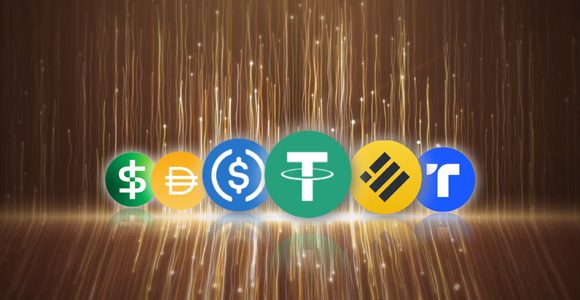As larger financial companies, such as Bank of America and Fiserv, are announcing that they’re moving into the stablecoin sector of cryptocurrencies, and banking conglomerates Morgan Stanley, Citigroup, and JPMorgan Chase have all publicly addressed their intentions to issue or be involved with stablecoins, many believe that this is the path towards a new everyday way to make payments and transfer money.
What are stablecoins?
Stablecoins aim to maintain the value of the asset backing them, while providing users with the speed and accessibility of cryptocurrencies to engage in either traditional markets or the digital blockchain. The largest stablecoin by market capitalization is Tether’s USDT, with roughly $155 billion in circulation. USDT accounts for approximately 60% of the total stablecoin supply. USDT is pegged to the US Dollar and is backed by a combination of reserves, primarily comprised of cash and short-term Treasury Bills. In other words, when users purchase one coin of Tether’s USDT or Circle’s USDC, its value is pegged at a roughly 1:1 ratio to the US Dollar. Meaning your coin, in theory, will always reflect the current dollar value. As demand increases, issuers of stablecoins will be required to purchase more of the underlying asset, typically cash and short-term treasury bills.
How is this different from Bitcoin or other cryptocurrencies?
The driving force behind Bitcoin’s price is demand. Bitcoin is not pegged to any external entity and has a limited supply. Cryptocurrencies, such as Bitcoin, may experience a price increase when favorable laws are passed, investor sentiment shifts favorably, or the acceptance of cryptocurrencies becomes more widespread.
Different Stablecoin Types
Fiat-Collateralized Stablecoins- Meaning that the coin is pegged to and backed by other fiat currencies such as the US Dollar or the Euro. Fiat currencies are not pegged to a hard commodity; instead, they are backed by the creditworthiness of the issuer and the public’s trust in the issuer.
Commodity Collateralized – Similar to the USD’s historical backing by Gold, commodity collateralized refers to the issuer holding reserves of a tangible asset, such as gold, silver, or oil.
Cryptocurrency Collateralized- Commonly referred to as on-chain stablecoins. The issuer of the stablecoin will maintain reserves of a cryptocurrency, such as ether or bitcoin, to achieve the price stability of a fiat currency, like the US Dollar.
Algorithmic Stablecoins- Commonly referred to as non-collateralized, are issued by issuers who control the supply and value of the stablecoin based on the value of the asset to which it is pegged. If the demand for the stablecoin exceeds its peg, causing its price to rise while the pegged value remains steady, issuers can adjust the stablecoin supply to align the price with the fiat currency.
What is the use of stablecoins right now?
Stablecoins have proven to be highly practical and versatile for remittances, allowing individuals to send money to family members or business partners overseas. This has become an everyday use for stablecoins, thanks to their instantaneous transfer and ability to lower fees. Sending Stablecoins overseas can cut out middlemen like banks and money transfer services like Western Union, which often charge substantial fees.
Lending stablecoins has also become more common as the demand for a Decentralized financial and banking system rises. Users can convert their dollars into stablecoins and lend them, just as a bank would lend to a customer. Your digital assets will be placed into a “liquidity pool” that serves as an open-source, shared reserve. Currently, loans are collateralized by the borrowers’ cryptocurrencies.
Chipotle, Whole Foods, GameStop, and even Gucci now accept stablecoins as a medium of exchange, one reason being the reduced transaction fees. Crypto platforms, such as Bitrefill, allow users to exchange their stablecoins for gift cards that can be used at over 300 major retail stores, including Amazon, Walmart, Home Depot, and Starbucks. Cryptocurrencies can also be used on these sites to purchase Visa gift cards, which are accepted at most large retail stores.
Should you add Stablecoins to your “wallet”?
Stablecoins have gained significant momentum in recent years, and their role in financial markets is expected to keep expanding. Companies such as Bullish and Circle have already reached valuations between $5 billion and $10 billion, even before going public, highlighting the strong institutional and investor interest in this space.
With that said, the road ahead is far from straightforward. Stablecoins and cryptocurrencies continue to face substantial regulatory challenges. In the coming years, additional policies are expected, with the current administration already laying the groundwork through the GENIUS Act, signed in July 2025. Under this legislation, all stablecoin issuers are subject to the Bank Secrecy Act, which requires effective anti-money laundering compliance programs to mitigate sanction evasion and assist enforcement agencies. The GENIUS Act also mandates 100% reserve backing with highly liquid assets, such as cash and short-term Treasuries, ensuring greater transparency and protection for investors, and that their stablecoin has the technical ability to be frozen or seized if legally required.
The real-world applications of stablecoins cannot be overlooked. They have already proven to be an efficient tool for facilitating cross-border payments, while reducing or even eliminating transaction fees. These features make them a practical solution for certain types of financial activity, and their integration into traditional financial markets is likely to deepen over time.
For individuals considering building a digital wallet, safeguarding your assets should remain a top priority. Take the time to research before investing in digital assets and implement strong security practices. Use secure networks, consider a VPN, and enable multi-factor authentication on all devices and applications that store sensitive financial data.



